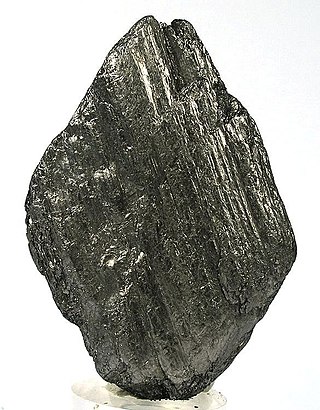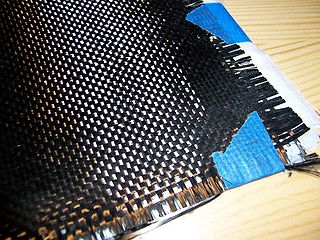
Graphite is a crystalline form of the element carbon. It consists of stacked layers of graphene. Graphite occurs naturally and is the most stable form of carbon under standard conditions. Synthetic and natural graphite are consumed on a large scale for uses in pencils, lubricants, and electrodes. Under high pressures and temperatures it converts to diamond. It is a good conductor of both heat and electricity.

I. G. Farbenindustrie AG, commonly known as IG Farben, was a German chemical and pharmaceutical conglomerate. Formed in 1925 from a merger of six chemical companies—BASF, Bayer, Hoechst, Agfa, Chemische Fabrik Griesheim-Elektron, and Chemische Fabrik vorm. Weiler Ter Meer—it was seized by the Allies after World War II and divided back into its constituent companies.

Carbon fibers or carbon fibres are fibers about 5 to 10 micrometers (0.00020–0.00039 in) in diameter and composed mostly of carbon atoms. Carbon fibers have several advantages: high stiffness, high tensile strength, high strength to weight ratio, high chemical resistance, high-temperature tolerance, and low thermal expansion. These properties have made carbon fiber very popular in aerospace, civil engineering, military, motorsports, and other competition sports. However, they are relatively expensive compared to similar fibers, such as glass fiber, basalt fibers, or plastic fibers.

Siemens AG is a German multinational technology conglomerate. Its operations encompass automation and digitalization in the process and manufacturing industries, intelligent infrastructure for buildings and distributed energy systems, rail transport solutions, as well as health technology and digital healthcare services. Siemens is the largest industrial manufacturing company in Europe, and holds the position of global market leader in industrial automation and industrial software.

Hoechst AG was a German chemicals then life-sciences company that became Aventis Deutschland after its merger with France's Rhône-Poulenc S.A. in 1999. With the new company's 2004 merger with Sanofi-Synthélabo, it became a subsidiary of the resulting Sanofi-Aventis pharmaceuticals group.

Celanese Corporation, formerly known as Hoechst Celanese, is an American technology and specialty materials company headquartered in Irving, Texas. A Fortune 500 corporation, the company is the world’s leading producer of acetic acid, producing about 1.95 million tonnes per year, representing approximately 25% of global production. Celanese is also the world's largest producer of vinyl acetate monomer (VAM).
Eastman Chemical Company is an American company primarily involved in the chemical industry. Once a subsidiary of Kodak, today it is an independent global specialty materials company that produces a broad range of advanced materials, chemicals and fibers for everyday purposes. Founded in 1920 and based in Kingsport, Tennessee, the company now has more than 50 manufacturing sites worldwide and employs approximately 14,000 people.

Ciba was a chemical company based in and near Basel, Switzerland. "Ciba" stood for "Chemische Industrie Basel" and was formed when the non-pharmaceuticals elements of Novartis were spun out in 1997, following the merger in the previous year of Ciba-Geigy and Sandoz that created Novartis.

The Lenzing Group is an international group with its headquarters in Lenzing, Austria, and production sites in all major markets. Lenzing produces wood-based viscose fibers, modal fibers, lyocell fibers and filament yarn, which are used in the textile industry — in clothing, home textiles and technical textiles — as well as in the nonwovens industry. In addition, the company is active in mechanical and plant engineering. The Lenzing Group markets its products under the brand names TENCEL, VEOCEL, LENZING ECOVERO and LENZING.
OSRAM Licht AG is a German company that makes electric lights, headquartered in Munich and Premstätten (Austria). OSRAM positions itself as a high-tech photonics company that is increasingly focusing on sensor technology, visualization and treatment by light. The company serves customers in the consumer, automotive, healthcare and industrial technology sectors. The operating company of OSRAM is OSRAM GmbH.

Continental AG, commonly known as Continental or colloquially as Conti, is a German multinational automotive parts manufacturing company that specializes in tires, brake systems vehicle electronics, automotive safety, powertrain, chassis components, tachographs, and other parts for the automotive and transportation industries. Continental is structured into six divisions: Chassis and Safety, Powertrain, Interior, Tires, ContiTech, ADAS. It is headquartered in Hanover, Lower Saxony. Continental is the world's third-largest automotive supplier and the fourth-largest tire manufacturer.
The American IG Chemical Corporation, or American IG for short, was an American holding company incorporated under the Delaware General Corporation Law in April 1929 and headquartered in New York City. It had stakes in General Aniline Works (GAW), Agfa-Ansco Corporation, and Winthrop Chemical Company, among others, and was engaged in manufacture and sale of pharmaceuticals, photographic products, light weight metals, synthetic gasoline, synthetic rubber, dyes, fertilizers, and insecticides. The Moody's industrial manual listed an affiliation between IG Farben and American IG at the time of founding. First, Hermann Schmitz, who was the second after Carl Bosch in IG Farben's hierarchy, and then his brother, Dietrich A. Schmitz, served as American IG's presidents. It was re-incorporated as General Aniline & Film (GAF) Corp. in 1939 after a merger with General Aniline Works.

The PACE Award is an annual award from Automotive News. The focus of the award is an innovation (i) developed primarily by a supplier, (ii) that is new to the automotive industry, (iii) that is in use, and (iv) that "changes the rules of the game". Awards have been given for products, materials, processes, capital equipment, software and services. A panel of independent judges from industry, finance, research, and academia choose finalists from the initial applicants, make site visits to evaluate the innovation, and then gather to select winners, independent of the sponsors. Winners to date include suppliers from Japan, Korea, China, the US, Canada, Brazil, Germany, France, Italy, Poland and other European countries. Among the most awarded companies over the years are BorgWarner, Delphi Automotive, Federal-Mogul, Valeo and PPG Industries as well as Robert Bosch GmbH, Gentex Corporation, and Siemens.

Meitingen is a market town in the district of Augsburg, in Bavaria, Germany. It is situated on the left bank of the Lech, 20 km (12 mi) south of Donauwörth, and 21 km (13 mi) north of Augsburg.
Benteler International AG (BENTELER) is a holding company in German family ownership. The Group companies operate worldwide in the fields of automotive technology, steel and tube production and engineering. The headquarters of Benteler International AG is in Salzburg (Austria), as of 2010. The owner is the Benteler family.

Mahle GmbH is a German automotive parts manufacturer based in Stuttgart, Germany. It is one of the largest automotive suppliers worldwide. As a manufacturer of components and systems for the combustion engine and its periphery, the company is one of the three largest systems suppliers worldwide for engine systems, filtration, electrics, mechatronics, and thermal management. In 2018, Mahle's sales amounted to over €12.5 billion.

Tokai Carbon Co., Ltd. is a Japanese company. The company is a developer and stockist of graphite material for use in nuclear power, particularly electrical discharge machining electrode, high temperature, and mechanical applications.
Dade Behring was a company which manufactured testing machinery and supplies for the medical diagnostics industry, based in Deerfield, Illinois and Glasgow, Delaware.
GrafTech International Ltd. is a manufacturer of graphite electrodes and petroleum coke, which are essential for the production of electric arc furnace steel and other metals. The company is headquartered in Brooklyn Heights, Ohio and has manufacturing facilities in Calais, France, Pamplona, Spain, Monterrey, Mexico, and St. Marys, Pennsylvania.

Ronal AG is a manufacturer of wheels for cars and commercial vehicles, with its headquarters in Härkingen, Switzerland. The company employs more than 8000 personnel and produces both cast and forged wheels. The company is active in both the OEM and aftermarket for cars and commercial vehicles.














